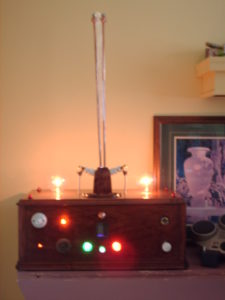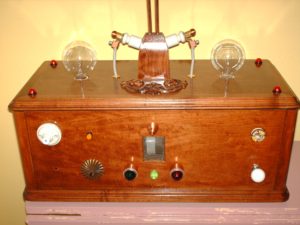Bill Englander is an out-of-the-box tinkerer. His most recent project was building a Jacob’s Ladder for the newly rebranded Spark Museum in Bellingham. We will just let Bill tell you in his own words below the video…
As a boy, I had two grandfathers who each taught me the fine art of tinkering and repair. Grandpa Englander whiled away his retirement gleaning old wooden wall phones from the early 20th century, removing the innards, and turning them into radios by installing newfangled transistor radios in the 1950s. Grandpa Hastings could and would repair anything and everything. Grandma had a cartoon framed on her kitchen wall that summed up Grandpa’s handiness: amid a background of ringer washers, Model-Ts, and old appliances, an Old Woman says to an Old Man holding an antique toaster, ” I KNOW you can fix it – you can fix anything. I WANT A NEW ONE!”

I probably saw my first Jacob’s Ladder as a kid watching the original Frankenstein movie on TV. All my life I wanted to build one; it was just too cool for school. In 2008 I purchased a used 15,000 volt neon transformer, which sat on a shelf until the summer of 2010 due to my innate fear of electrocuting myself in the process of pursuing my hobby. Finally, I got up the nerve to begin designing my first ladder. I scrounged an old rectangular radio case from the Museum of Radio and Electricity, purchased a motion sensor, touch switch, sockets, switches, lighting parts, and miscellaneous neat-looking stuff, all from The RE Store, and tinkered off and on for three months to the finished product.
The current ladder (pun intended) was created for the renamed Spark Museum of Electrical Invention with generous assistance from The RE Store, which supplied the futuristic-looking cap on the cylinder, the cap on the base, and all the brass bling on the base. The borosilicate glass protective cylinder is a pipe salvaged from a secret bio-weapons laboratory in Downtown Bellingham located in the Spark Museum’s “basement.” Sherwin-Williams donated the five-gallon you-know-what base; CDI Signs supplied the transformer. Radio Shack was nice enough to sell me the blinking LEDs and resistors. Other parts were scrounged from my electrical box-o-goodies and “elsewhere.” I put about 40 hours into this one.

I volunteer at the Museum. I noticed a year ago that the popular Jacob’s Ladder on exhibit was – in a word – fried. The device creates ozone when it operates by burning air – O2. This is of course great for the stratosphere, but bad for anything metallic, ’cause ozone is corrosive, especially the metal in the Jacob’s Ladder enclosed in a Plexiglass box, such as it was. The poor thing literally ate itself. The new version includes a proprietary “Ozone Drain” (a plastic tube) that removes the ozone by gravity, as it is heavier than air. The original design of my replacement ladder turned on by motion (The RE Store’s proximity sensor switch); the Museum expressed concern the ladder might continually cycle “ON” due to patrons flocking to it like bees to a flower, and subsequently go nuclear without warning. So I ripped out the motion sensor and replaced it with a switch and a timer cannibalized from the dead ladder.
Giving up my baby (the newly completed Jacob’s Ladder) felt like losing a favorite shoe. But I’m pulling out of it, and designing my next creation; I just hope it’s an 8 1/2 Left.
~ Bill Englander
